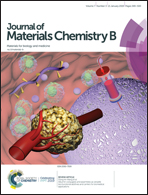Zn(ii) coordination to cyclen-based polycations for enhanced gene delivery†
Abstract
1,4,7,10-Tetraazacyclododecane (cyclen) has a unique cyclic structure that endows it with a number of characteristics, including its cationic nature, easy modification and strong coordination ability toward a wide range of cations. Zn2+, which can easily coordinate to cyclen, is an essential metal ion for DNA binding. In this report, Zn(II)–polycations derived from cyclen were studied as non-viral gene delivery vectors. Polycations were synthesized from diglycidyl ethers and cyclen through ring-opening polymerization, and then Zn(II)-complexes were obtained by reacting the polycations with Zn(NO3)2·6H2O. UV absorption and circular dichroism spectra revealed that the Zn(II)-complexes may induce apparent conformational changes of DNA, while polycations could not. Agarose gel retardation assay demonstrated that although the Zn(II)–polycations exhibited slightly lower DNA binding ability compared to their polycation counterparts, they showed better DNA release, which might favor the gene transfection process. In vitro transfection results revealed that the coordination of Zn(II) may dramatically increase the transfection efficiency of the polymers. In addition, almost all polycations and their Zn(II)-complexes exhibited better serum tolerance than polyethylenimine (PEI), especially Zn-cyclen-HD. Flow cytometry and BSA adsorption experiments also demonstrated the good serum tolerance of the Zn(II)–polycations. Meanwhile, such materials also exhibited acceptable cytotoxicities at transfection dosages. These results may afford us clues for developing novel non-viral gene vectors with high efficiency and biocompatibility.



 Please wait while we load your content...
Please wait while we load your content...